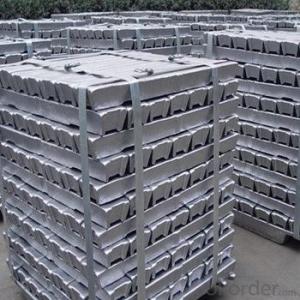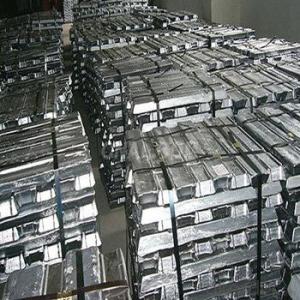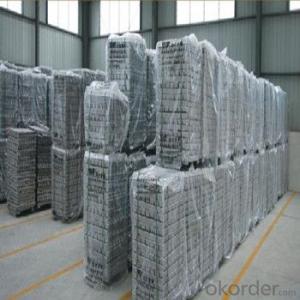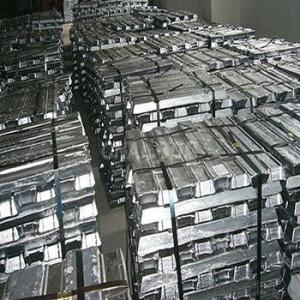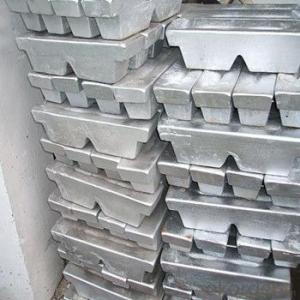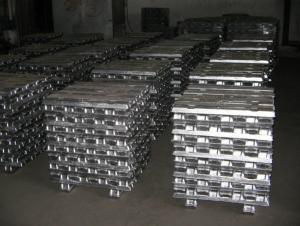Aluminium Ingot with 99.7% Purity and Wholesale from Mill
- Loading Port:
- China main port
- Payment Terms:
- TT OR LC
- Min Order Qty:
- 1000 m.t.
- Supply Capability:
- 10000 m.t./month
OKorder Service Pledge
OKorder Financial Service
You Might Also Like
Pure Aluminum Ingot Used for Industry
1.Structure of Aluminum Ingot Description
Aluminum Ingot is with the AL as the main chemical composition. Aluminum Ingot is used for industry,such as automobile,pinning and weaving,electron broadly and so on. Aluminum Ingot has the following advantages: easy control and operation, fast melting.
2.Main Features of the Aluminum Ingot
•High Purity
•Easy control and operation
•High strength
•Fast melting
•Competitive price
•Best Service
3. Aluminum Ingot Images
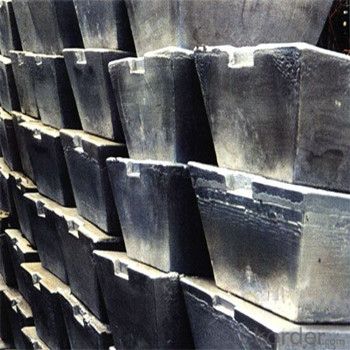
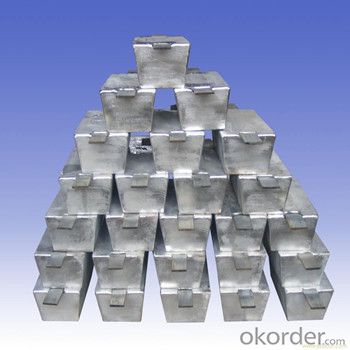
4. Aluminum Ingot Specification
Grade | Chemical Composition % | |||||||||
Al≥ | impurities ≤ | |||||||||
Si | Fe | Cu | Ga | Mg | Zn | Mn | others | Sum | ||
Al99.9 | 99.90 | 0.50 | 0.07 | 0.005 | 0.02 | 0.01 | 0.025 | - | 0.010 | 0.10 |
Al99.85 | 99.85 | 0.80 | 0.12 | 0.005 | 0.03 | 0.02 | 0.030 | - | 0.015 | 0.15 |
Al99.7 | 99.70 | 0.10 | 0.20 | 0.010 | 0.03 | 0.02 | 0.030 | - | 0.030 | 0.30 |
Al99.6 | 99.60 | 0.16 | 0.25 | 0.010 | 0.03 | 0.03 | 0.030 | - | 0.030 | 0.40 |
Al99.5 | 99.50 | 0.22 | 0.30 | 0.020 | 0.03 | 0.05 | 0.050 | - | 0.030 | 0.50 |
Al99.00 | 99.00 | 0.42 | 0.50 | 0.020 | 0.03 | 0.05 | 0.050 | - | 0.050 | 1.00 |
5.FAQ of Aluminum Ingot
We have organized several common questions for our clients,may help you sincerely:
①How about your company?
A world class manufacturer & supplier of castings forging in carbon steel and alloy steel,is one of the large-scale professional investment casting production bases in China,consisting of both casting foundry forging and machining factory. Annually more than 8000 tons Precision casting and forging parts are exported to markets in Europe,America and Japan. OEM casting and forging service available according to customer’s requirements.
②How to guarantee the quality of the products?
We have established the international advanced quality management system,every link from raw material to final product we have strict quality test;We resolutely put an end to unqualified products flowing into the market. At the same time, we will provide necessary follow-up service assurance.
③How long can we receive the product after purchase?
In the purchase of product within three working days, We will arrange the factory delivery as soon as possible. The pecific time of receiving is related to the state and position of customers.Commonly 7 to 10 working days can be served.
- Q:How are aluminum ingots used in the production of railway components?
- Aluminum ingots are used in the production of railway components as they serve as the raw material for casting or forging various parts such as frames, body panels, doors, windows, and even wheels. These ingots are melted down and then shaped into the desired components through processes like extrusion or machining. The use of aluminum in railway components offers advantages like lightweight construction, corrosion resistance, and improved energy efficiency.
- Q:How is the purity of an aluminum ingot determined?
- The purity of an aluminum ingot is typically assessed using various analytical techniques, with one of the most common methods being the utilization of a spectrometer to measure the elemental composition. This method, known as optical emission spectroscopy (OES) or spark testing, involves vaporizing a small sample of the ingot using an electric spark and analyzing the resulting emission of light. Each element emits a distinct spectrum of light, and by comparing the intensities of these spectral lines to known standards, the concentration of different elements in the ingot can be determined. This allows for the identification and quantification of impurities such as iron, copper, silicon, and other trace elements. Another approach to evaluating purity is through chemical analysis, which entails dissolving a sample of the ingot in an appropriate acid or solvent and conducting various chemical reactions to quantify the impurities. For instance, atomic absorption spectroscopy (AAS), a common technique, can be utilized to measure the concentration of specific elements in the solution. In addition to these analytical techniques, non-destructive tests like ultrasound or X-ray analysis can also be employed to assess the integrity and purity of the aluminum ingot. These methods are capable of detecting any internal flaws or inclusions that could potentially impact the quality of the ingot. In conclusion, a combination of these analytical techniques is employed to determine the purity of an aluminum ingot, ensuring that it meets the necessary specifications for diverse industrial applications.
- Q:What are the different finishing processes for aluminum ingots?
- There are several different finishing processes for aluminum ingots, including hot rolling, cold rolling, extrusion, and casting. Hot rolling involves heating the ingot and passing it through a series of rollers to flatten and shape it. Cold rolling is similar, but the ingot is not heated, resulting in a harder and more precise product. Extrusion involves forcing the molten aluminum through a die to create a specific shape or profile. Casting, on the other hand, involves pouring the molten aluminum into a mold to create a solid form. These processes help to enhance the strength, durability, and aesthetic qualities of aluminum ingots for various applications.
- Q:What are the advantages of using recycled aluminum ingots?
- There are multiple benefits to utilizing recycled aluminum ingots: 1. Environmental advantages: The utilization of recycled aluminum ingots requires significantly less energy than extracting it from its raw state. By incorporating recycled aluminum ingots, we can decrease energy consumption and greenhouse gas emissions. Furthermore, recycling aluminum aids in conserving natural resources and reducing the necessity for mining, which can have adverse environmental consequences. 2. Cost efficiency: Over the long term, the use of recycled aluminum ingots can be cost-effective. Recycling aluminum necessitates less energy and resources in comparison to manufacturing new aluminum, resulting in lower production costs. These cost savings can be passed on to consumers, making recycled aluminum products more affordable. 3. Waste reduction: Through aluminum recycling, we can divert a substantial amount of waste from landfills. Aluminum is a highly recyclable material, and its recycling decreases the need for disposal and the associated expenses. Additionally, recycling aluminum prevents the accumulation of aluminum waste, which can take centuries to decompose. 4. Energy conservation: The production of aluminum from recycled ingots requires only a fraction of the energy required for primary production. Recycling aluminum saves up to 95% of the energy used in primary production, making it an energy-efficient choice. This energy conservation also leads to a reduction in carbon emissions. 5. Positive economic impact: The recycling industry plays a significant role in job creation and economic growth. By utilizing recycled aluminum ingots, we support the recycling industry and contribute to local economies. Additionally, the use of recycled aluminum reduces dependence on imported raw materials, which can have economic benefits for countries. 6. Versatility and quality: Recycled aluminum ingots can be utilized to manufacture a wide range of products, similar to primary aluminum. The quality of recycled aluminum is comparable to that of primary aluminum, making it suitable for various applications. Its versatility allows for the creation of high-quality, durable, and dependable products. In conclusion, the use of recycled aluminum ingots offers numerous advantages, including environmental benefits, cost efficiency, waste reduction, energy conservation, positive economic impact, and the ability to produce high-quality products. It is an exceptional choice for individuals and businesses seeking to minimize their environmental impact and contribute to a more sustainable future.
- Q:What is an aluminum ingot?
- An aluminum ingot is a solid block or bar of aluminum that has been cast or processed into a specific shape for storage, transportation, or further manufacturing purposes. It is typically obtained by melting aluminum and pouring it into a mold to solidify into a desired form. These ingots are commonly used as raw materials in various industries, including construction, automotive, aerospace, and electronics, where aluminum's lightweight, corrosion-resistant, and malleable properties are highly valued.
- Q:Can aluminum ingots be used in 3D printing?
- Yes, aluminum ingots can be used in 3D printing. Aluminum is a commonly used material in additive manufacturing due to its lightweight, high strength, and excellent thermal conductivity. However, instead of directly using aluminum ingots, a process called powder bed fusion, specifically selective laser melting (SLM) or electron beam melting (EBM), is utilized. In this process, fine aluminum powder is spread in thin layers and selectively melted by a laser or electron beam, layer by layer, to create the desired 3D object. This allows for the production of complex geometries and precise parts with high strength and accuracy.
- Q:Difference between ingots and alumina
- Our daily industrial material called aluminum ingots, it is made of alumina cryolite by electrolysis aluminum is produced. The standard containing 99.7% aluminum ingots, registered in the London market is it.
- Q:Does the pure aluminium ingot need to be removed in addition to the slag after melting?
- Specific look at the accuracy of your die-casting, strict requirements can not be removed, reducing costs, more competitive
- Q:How can I extract aluminium ingots from cans?
- That thing contains a lot of impurities, but also to remove the magnesium, zinc, manganese and other elements, these processes require professional personnel, layman is difficult to master.
- Q:What are the different forms of aluminum ingots available in the market?
- There are several different forms of aluminum ingots available in the market, including standard ingots, T-ingots, sow ingots, and rolled ingots.
1. Manufacturer Overview |
|
|---|---|
| Location | |
| Year Established | |
| Annual Output Value | |
| Main Markets | |
| Company Certifications | |
2. Manufacturer Certificates |
|
|---|---|
| a) Certification Name | |
| Range | |
| Reference | |
| Validity Period | |
3. Manufacturer Capability |
|
|---|---|
| a)Trade Capacity | |
| Nearest Port | |
| Export Percentage | |
| No.of Employees in Trade Department | |
| Language Spoken: | |
| b)Factory Information | |
| Factory Size: | |
| No. of Production Lines | |
| Contract Manufacturing | |
| Product Price Range | |
Send your message to us
Aluminium Ingot with 99.7% Purity and Wholesale from Mill
- Loading Port:
- China main port
- Payment Terms:
- TT OR LC
- Min Order Qty:
- 1000 m.t.
- Supply Capability:
- 10000 m.t./month
OKorder Service Pledge
OKorder Financial Service
Similar products
New products
Hot products
Related keywords







